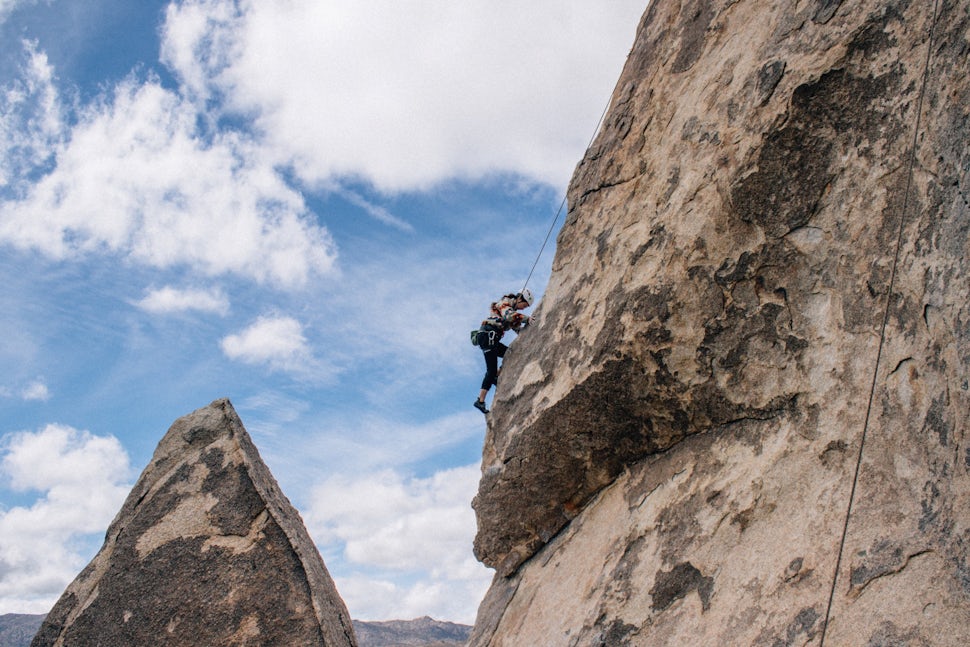4 Tips to Help You Take Your Gym Climbing Outdoors
You're flying through the grades at your local climbing gym and inevitably asking yourself...what's next?

So you've officially dropped in. You have your shoes, harness, belay device, and cool personalized chalk bag. You've spent the last few months building up finger strength, sanding down calluses (and inevitably tearing them off), mastering your knots and belay technique...so now what?
If you're anything like me, the gym is only a means to an end, and that end is standing on top of an actual rock somewhere out in actual nature with an actual view. You didn't get into climbing to spend the rest of your life pulling on plastic!
Making the transition from gym climbing to outdoor climbing can be intimidating. It's one thing to walk up to a color-coded wall with a prefixed rope, another thing entirely to walk up to a blank rock and know what to do next. These few tips will give you the catalyst you need to make the jump!
1. Familiarize Yourself!
There are countless videos on the internet explaining how to set up a top-rope system outdoors. Watch one of these. Watch all of these. Even if you don't remember every detail, you'll start to get an idea of the main concepts of anchor building. Having a base-level familiarity will give you a head start when you learn how to build these systems outdoors. Make sure you have your basic climbing gear ready before you head out!
2. Go With Someone Experienced!
It goes without saying that climbing is dangerous, but trying to set up an unfamiliar system which you intend to trust your life to at the top of a cliff without consulting an expert is next-level-dumb. A YouTube video or step-by-step .pdf is no replacement for a good, old-fashioned, hands-on teacher. The good news is the climbing community is unbelievably generous, kind, and welcoming to fresh climbers! Make friends with nearly any of your gym staff and I'm sure you'll meet someone willing to show you the ropes. (I'll only make that joke once. There. It's done.) You can also look up local guiding services wherever you live to have a certified instructor teach you the systems.
An added bonus is that this person or guide will most likely have specialized gear like ropes, slings, quickdraws, and other tools to build anchors and climb safely. You don't have to drop $200 for a rope just yet!
(Or, if you live in Los Angeles, hit me up! I'm always looking for new climbing partners.)
3. Start Easy!
You might be cranking on 5.11b's in the gym but as soon as you take away the brightly colored holds and obvious sequences, things get a lot more difficult. The steepest learning curve for climbing outside is simply reading the sequences. Figuring out where to place your foot next can be more difficult than actually making the move.
Don't be afraid to start on a 5.5 or 5.6 (or a 5.3 if you're in Joshua Tree...that shit's scary!). Working your way back up to your gym grade might take a matter of weeks or months on the wall, so be patient and have fun with the process!
4. Go OFTEN!
As with any activity, the only way to improve is to do it frequently. Learning new systems, knots, and techniques takes time to master. At first, it will feel like a huge undertaking to get gear together and head out to the local crag but with time it will become routine. Soon, you'll be able to equalize anchors in your sleep and have no problem cruising out for a couple-hour session before sunset!
**These tips are by no means a replacement for professional training. The safest way to learn these skills is to work with a trained instructor.**
We want to acknowledge and thank the past, present, and future generations of all Native Nations and Indigenous Peoples whose ancestral lands we travel, explore, and play on. Always practice Leave No Trace ethics on your adventures and follow local regulations. Please explore responsibly!
Do you love the outdoors?
Yep, us too. That's why we send you the best local adventures, stories, and expert advice, right to your inbox.








